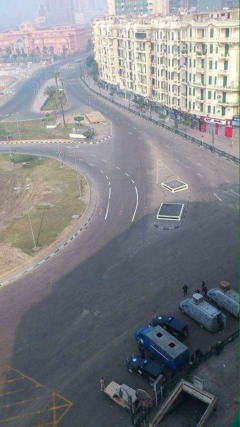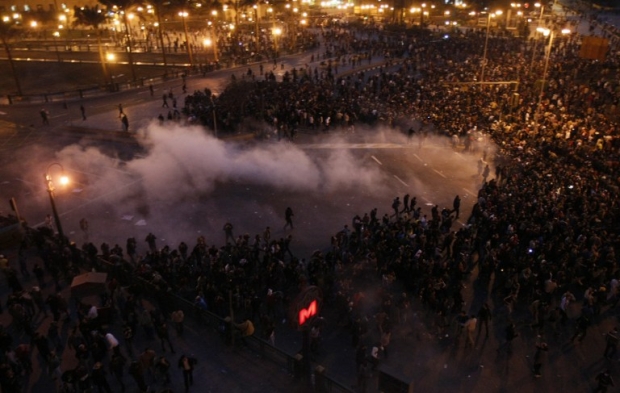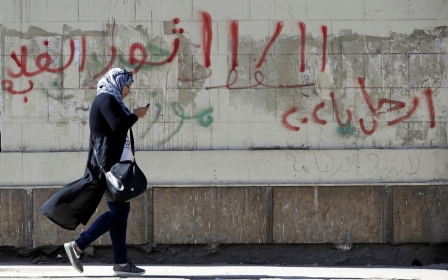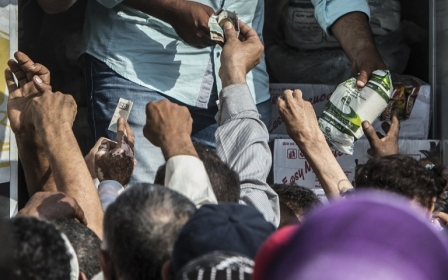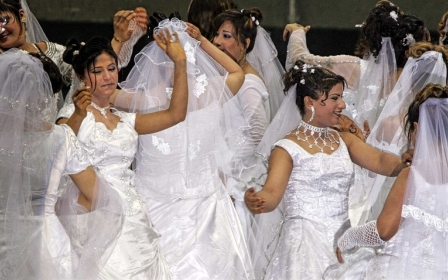11/11 in Egypt: The invisible demonstrations
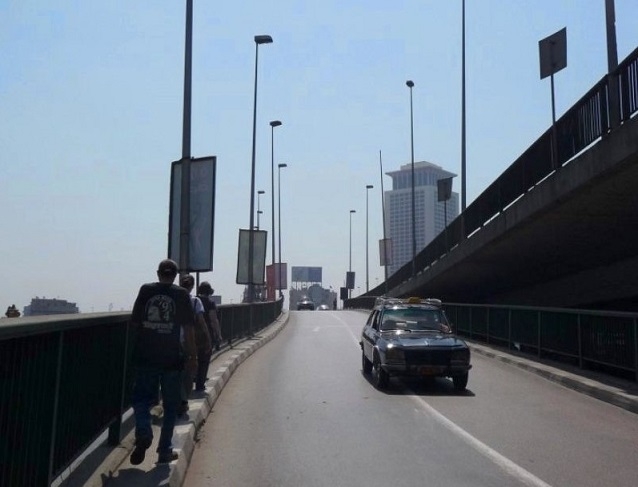
“This is the largest number of guns I have ever prayed with,” Haitham el-Tabei, AFP’s Cairo correspondent, told me. “The number of security praying exceeded the civilian faithful.”
Today, a numerical oddity of four 1s failed because trepidation and lack of trust ruled the day
Such was the government’s fear of planned demonstrations on 11/11. In President Abdel Fattah al-Sisi’s Egypt, anger may be rising daily but it is nowhere near the boiling point.
You see, where anger and fear mix, in an iron-fist state like Sisi’s, the latter has a habit of winning until the kettle screeches.
Though the consequences of a recent devaluation have had devastating effects on millions of Egyptians, a disorganised opposition never stood behind the call for a day of anger whose sources were, to say the least, mysterious.
For weeks now, a loud, yet strangely below-the-radar message by a man named Yasser Omda, founder of the Tahrir Revolutionary party and spokesperson for the revolution of the poor, had gone out for demonstrations on 11/11.
Many in revolutionary and activist circles, including this analyst, had their doubts about the man, the party, and the stated goals of the demonstrations.
Nonetheless, the timing of the planned demonstrations, coming a mere eight days after the Egyptian pound was devalued by 48 percent against the US dollar, focused microscopes on the day.
But there were more questions than answers. What was this party? Who is that person? If real, why aren’t major opposition parties lining up to organise? Would the very "poor" whom the day targeted respond?
And is this a front for Egyptian security agencies in an effort to deal a death blow to what little remained of an opposition torn to the smallest pieces?
The rumble of whispers
Some may, reasonably, argue that revolutions don’t announce themselves.
Equally, many logical observers could point to the January 25 revolution that was, indeed, organised and announced many days in advance on Facebook, Twitter and YouTube.
Just as intelligence agencies make their way among the people in order to understand the “mood of the street” so do activists, journalists and analysts.
Five days before 11/11, there was an increased sense of urgency, sources in Cairo told me. Nothing was definite, but anger was being expressed outside of prototypical Islamist flash points.
Even in typically pro-government circles, stories were being told of women in a queue at a government ministry speaking openly and quite angrily about the International Monetary Fund-directed price hikes. That, in and of itself, was a highly telling development.
Spreading pain
A Reuters headline this week captured the post-devaluation political and economic atmosphere: “Egypt to face pain before gain after massive currency devaluation."
Stories of pain filled daily conversations not just among the vulnerable millions in and around poverty, but also at the heart of the middle and the upper middle class too
Those stories of pain filled daily conversations and, worryingly, did not just strike among the vulnerable millions in and around poverty but also at the heart of the middle and the upper middle class too.
Beginning with reports that the price of bread had increased 25 piasters (33 percent) in some quarters to missing medicine because of the huge increase in the price of the dollar and stretching to an unimaginable rise in the price of education.
Being one of the most expensive places of education in the entire Middle East did not stop the American University in Cairo (AUC) from raising its tuition from 110,000 EGP to a monstrous 200,000 ($12,100). “My father is not a thief… you are the thief,’’ the students chanted while demonstrating against the university administration.
Now imagine a population that averages living on just slightly north of $2 daily and then try to conceptualise the degree of “pain” they are suffering.When the eruption does happen - and it is not a matter of if, but when, how and by whom - the address will be the economy.
Who is more afraid?
So why did the demonstrations fail to materialise if anger is boiling over in so many quarters?
To begin with, 11/11 is not and was not an organic movement. The poor, in a nation like Egypt under its current dire circumstances, are neither organised nor, for the most part, educated. Their goal is not to revolt but to survive. To say otherwise is self-deception.
The poor under the current circumstances in Egypt are neither organised nor, for the most part, educated. Their goal is not to revolt but to survive
This important fact is no secret to Egyptian activists and revolutionaries alike and, for that very reason, only increased suspicion around the day of planned demonstrations supposedly by those in the very crosshairs of monstrously unjust economic measures.
Cairo’s empty streets and the mosque with more guns than faithful offer us a second reason for 11/11's failure. Fear of the regime’s gun is a solid, concrete reason for failure of the demonstrations.
If Egypt is so stable and anger so scarce, why are there more armoured carriers and police trucks in the streets than people on Friday, the day when Egyptians leave work behind?
Multiple reports by Western and Egyptian reporters relayed an image of a silent, empty capital, and cameras bore witness to the visible fear. Those few brave souls who ventured out to central Cairo after prayers were stopped and searched.
The few demonstrations that managed to get off the ground in Behira in the north, Minya in the south, and Daqhlia and Alexandria were met with arrests and a few rubber bullets and quickly quelled. There was nothing in comparison to the average Friday in the year following the 2013 coup.
Today, a numerical oddity of four 1s failed because trepidation and lack of trust ruled the day. 11/11 evaporated because people feared the true intent of organisers and a vicious regime so twitchy that it hunkered down in war-like positioning throughout the important thoroughfares.
This no-man’s land begs the question: is the government fearful or looking to implant fear? The answer, in an ever confounding Egypt, is: both.
For every 'no man', 10,000 more
With 27 million already under the poverty line, and another 4 million potentially heading there as a direct result of the IMF mandated policies, this will not be the end of the story.
For every ‘no man’ today, there are 10,000 waiting for the right moment
Today was just another day in the life of a nation teetering on the edge of a mountain of trouble.
The problem is that should the Egyptian opposition continue to be splintered - a natural state when you consider that 60,000 political prisoners languish in Sisi's prisons - it is likely that when the face-off occurs it will be written by the chaos of the streets rather than those with an agenda that may offer solutions. Unfiltered anger, history has shown, is a fire than can burn the innocent along with the guilty.
With prices soaring, safety nets voided by rampant corruption, a local economic vision dictated by an IMF that has a history of drowning rather than rescuing, a rising, but not yet boiling rage, the situation in Egypt today is more complex and unstable than ever.
Should the government choose to see the no-man demonstrations today as a sign of acceptance of a devaluation that has burned nearly all sectors, it will be in for a surprise of the sort that it will not handle.
For every "no man" today, there are 10,000 waiting for the right moment. People are looking not for revolution but for answers. Only right now, neither are to be found.
Sometimes, silence screams.
- Amr Khalifa is a freelance journalist and analyst recently published in Ahram Online, Mada Masr, The New Arab, Muftah and Daily News Egypt. You can follow him on Twitter@cairo67unedited.
The views expressed in this article belong to the author and do not necessarily reflect the editorial policy of Middle East Eye.
Photo: An empty bridge in Cairo (Sarah Stil)
Middle East Eye propose une couverture et une analyse indépendantes et incomparables du Moyen-Orient, de l’Afrique du Nord et d’autres régions du monde. Pour en savoir plus sur la reprise de ce contenu et les frais qui s’appliquent, veuillez remplir ce formulaire [en anglais]. Pour en savoir plus sur MEE, cliquez ici [en anglais].



